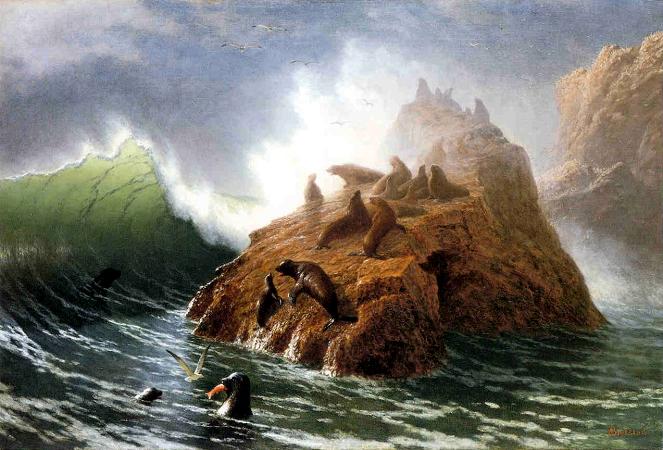Farallon Islands. The Farallon Islands, or Farallones, are a group of islands and sea stacks in the Gulf of the Farallones, off the coast of San Francisco, California, United States. The islands are also sometimes referred to by mariners as the Devil's Teeth Islands, in reference to the many treacherous underwater shoals in their vicinity. The islands lie 30 miles outside the Golden Gate and 20 miles south of Point Reyes, and are visible from the mainland on clear days. The islands are part of the City and County of San Francisco. The only inhabited portion of the islands is on Southeast Farallon Island, where researchers from Point Blue Conservation Science and the U.S. Fish and Wildlife Service stay. The islands are closed to the public. The Farallon Islands National Wildlife Refuge is one of 63 national wildlife refuges that have congressionally designated wilderness status. In 1974, the Farallon Wilderness was established and includes all islands except the Southeast Island for a total of 141 acres. Additionally, waters surrounding the islands are protected as part of the Greater Farallones National Marine Sanctuary. The islands were long known by the name Islands of the Dead to the Native Americans who lived in the Bay Area prior to the arrival of Europeans, but they are not thought to have traveled to them, either for practical reasons or because of spiritual beliefs. The first Europeans to see these islands were most probably the members of the Juan Cabrillo expedition of 1542 which sailed as far north as Point Reyes, but no source record of the Cabrillo expedition's actual sighting of these islands has survived. The first European to create a record of the islands that has survived was the English privateer and explorer Sir Francis Drake, on July 24, 1579. On that day, Drake landed on the islands to collect seal meat and bird eggs for his ship. He named them the Islands of Saint James because the day after his arrival was the feast day of St James the Great. The name of St James is now applied to only one of the rocky islets of the North Farallones. The islands were apparently first given their names of the Farallones by Friar Antonio de la Ascencion, aboard the Spanish explorer Sebastián Vizcaíno's 1603 expedition. De la Ascension wrote in his diary, Six leagues before reaching Punta de los Reyes is a large island, two leagues from land and three leagues northwest of this are. seven farallones close together. It is believed that probably for the next two centuries after their discovery, their rather ominous appearance, lying just off the entrance to San Francisco Bay, most likely caused the earlier mariners to prefer to skirt far to the west and offshore from the entrance to the bay, thus leading to the much later discovery of the San Francisco Bay by land over two centuries after the 1542 discovery of the islands. In 1769, the bay inlet was finally discovered soon after an overland sighting of the bay was made from what is now the Pacifica area. In the years following the discovery of the islands, during the Maritime Fur Trade era, the islands were exploited by seal hunters, first from New England and later from Russia. The Russians maintained a sealing station in the Farallones from 1812 to 1840, taking 1,200 to 1,500 fur seals annually, though American ships had already exploited the islands. The Albatross, captained by Nathan Winship, and the O'Cain, captained by his brother Jonathan Winship, were the first American ships sent from Boston in 1809 to establish a settlement on the Columbia River. In 1810, they met with two other American ships at the Farallon Islands, the Mercury and the Isabella, and at least 30,000 seal skins were taken. By 1818, the seals diminished rapidly until only about 500 could be taken annually and within the next few years, the fur seal was extirpated from the islands. Whether the northern fur seal or the Guadalupe fur seal were the islands' native fur seal is unknown, although the northern fur seal is the species that began to recolonize the islands in 1996. On July 17, 1827, French sea captain Auguste Duhaut-Cilly sailed by the southernmost Farallon Island and counted the crude dwellings of about a hundred Kodiaks stationed there by the Russians of Bodega.the Kodiaks, in their light boats, slip into San Francisco Bay by night, moving along the coast opposite the fort, and once inside this great basin, they station themselves temporarily on some of the inner islands, from where they catch the sea otter without hindrance.
more...



